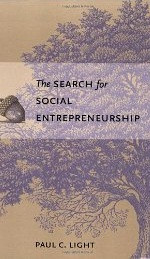It’s taken more than two decades, but people are finally recognizing the importance of social entrepreneurs.
These new stars are routinely invited to the World Economic Forum, are featured prominently at the Clinton Global Initiative, and have their own annual meeting at Oxford University, thanks to the Saïd Business School and the Skoll Foundation. Ashoka’s own network of social entrepreneurs invited its 2,000th member last year. And according to Ashoka’s University Network for Social Entrepreneurship, more than 350 faculty members are actively teaching or researching social entrepreneurship around the world. Some 30 universities run programs on social entrepreneurship, offering centers, majors, and master’s degrees.
In his new book, The Search for Social Entrepreneurship, Paul C. Light, professor of public service at New York University, uses his considerable talents to provide a rich discussion of the most important issues in the field of social entrepreneurship. Although other academics (J. Gregory Dees, Johanna Mair, and Alex Nicholls) have tracked social entrepreneurship’s growth for a number of years, Light brings a healthy skepticism and a critical eye to these issues. His book is well written, accessible to nonacademic readers, and datarich— Light balances substantial literature review (500 studies) with the presentation and analysis of his own multiple research endeavors.
Light begins with a review of the debates about how to define social entrepreneurs. Indeed, Light himself has criticized Ashoka for being too exclusive in its definition and leaving out others deserving of support and recognition. (See his article, “Reshaping Social Entrepreneurship,” in the fall 2006 issue of the Stanford Social Innovation Review.) To which I would respond, that yes, Ashoka has long defined the social entrepreneur as a one-in-10-million individual who has a new idea that can truly transform a society. But we also believe that all people can be “changemakers”—engaging in the very social entrepreneurial activity that Light discusses— as long as they take initiatives to fix the elements of our society that are broken. A leading social entrepreneur and a community of changemakers depend on each other for success: Social entrepreneurs need engaged, motivated citizens, and changemakers need social entrepreneurs as role models whose vision inspires them to act.
In his next chapters Light compares new and older organizations, and he presents data to challenge the notion that older organizations are less able to support new ideas when they arise from within. He lists factors that he believes keep organizations entrepreneurial: alignment around a vision, adaptability, alertness, and agility. (Ashoka’s critical factors, by comparison, have always been a new idea, entrepreneurial skill, social impact, and ethical fiber.)
Chapters 5 and 6 are the book’s most compelling. Light lays out his own survey of 131 organizations and explains his method, which was basically to ask the organizations’ leadership a series of questions and then sort them into three groups: highly entrepreneurial, moderately entrepreneurial, and not so entrepreneurial. This method allows him to compare the groups’ strategy and impact.
According to Light, the most entrepreneurial organizations have a greater percentage of engaged founders, governance models focused on driving innovation, more participatory leadership, and relatively at hierarchies. These organizations rapidly grow their budgets revenues and make a significant social impact. Light also concludes that the single most defi ning characteristic of the social entrepreneur is “perseverance against an array of obstacles.” And based on his data, Light now concedes that social entrepreneurship involves big change on a big scale.
Light also reminds us of the problems that social entrepreneurs face today. The most notable one is the unfortunate reality that socially entrepreneurial organizations need unrestricted funding to allow them to remain innovative. These are the most difficult types of investment funds to find, and it is becoming even harder to get them—unrestricted funding decreased between 2001 and 2006, even while revenue in the sector increased significantly. Ashoka’s own experience is that it is precisely unrestricted funding that provides the freedom for social entrepreneurs to explore and test new ideas from within; in other words, to practice as a learning institution.
What will we take away from Light’s findings? Academics will consider the book methodologically sound and a good overview of the literature. Potential investors in social entrepreneurship will use its insights to inform their investment decisions.
As for me, someone who’s built awareness around social entrepreneurship for two decades, I take away an appreciation for Light’s rich data and his insightful analysis, which led him to reverse some of his earlier assumptions about social entrepreneurs, or to have “a conversion,” as he terms it.
Data matter!
Diana Wells is president of Ashoka, a global organization that invests in and connects social entrepreneurs. She is also on the advisory board for the Center for the Advancement of Social Entrepreneurship at Duke University’s Fuqua School of Business, and a board member of GuideStar International.


